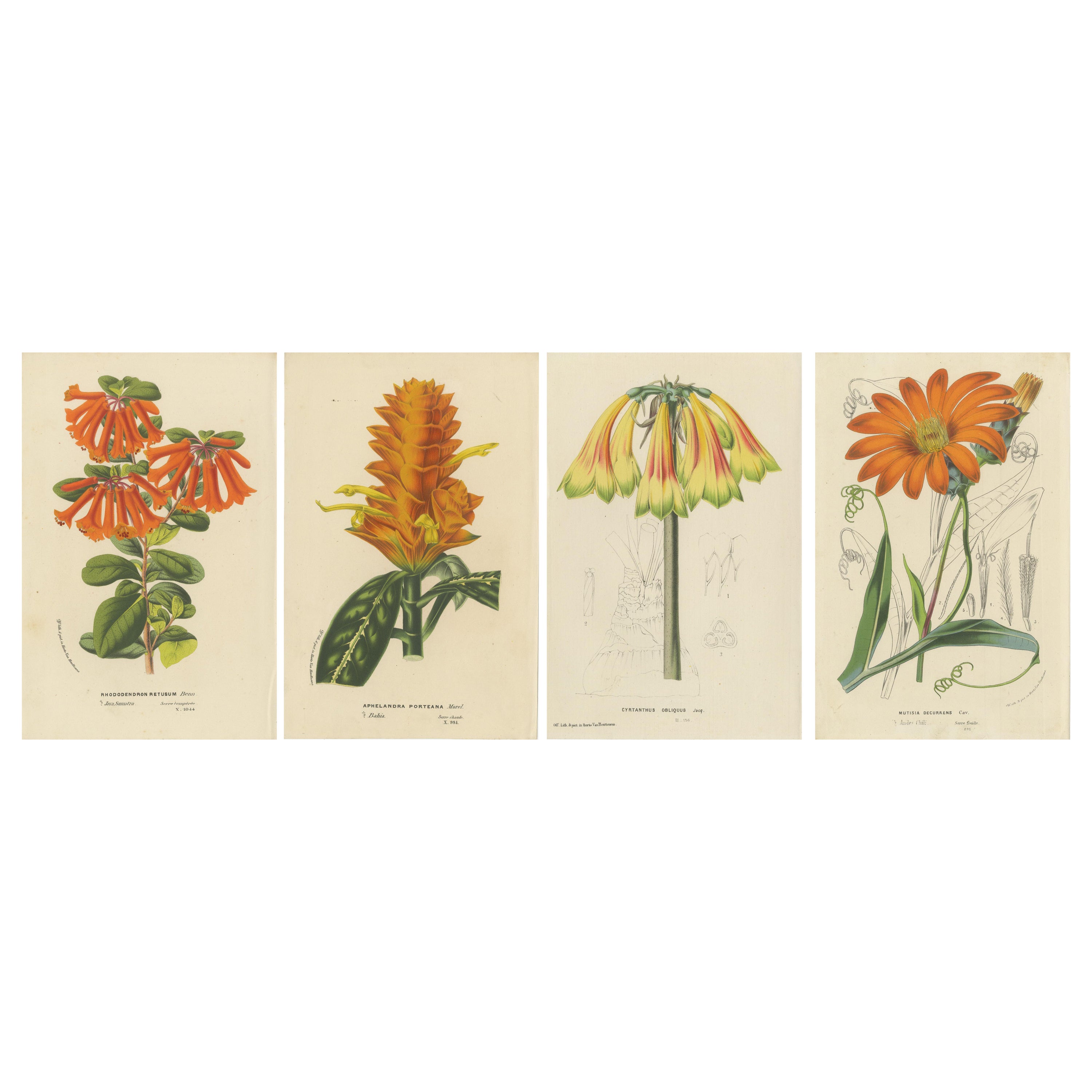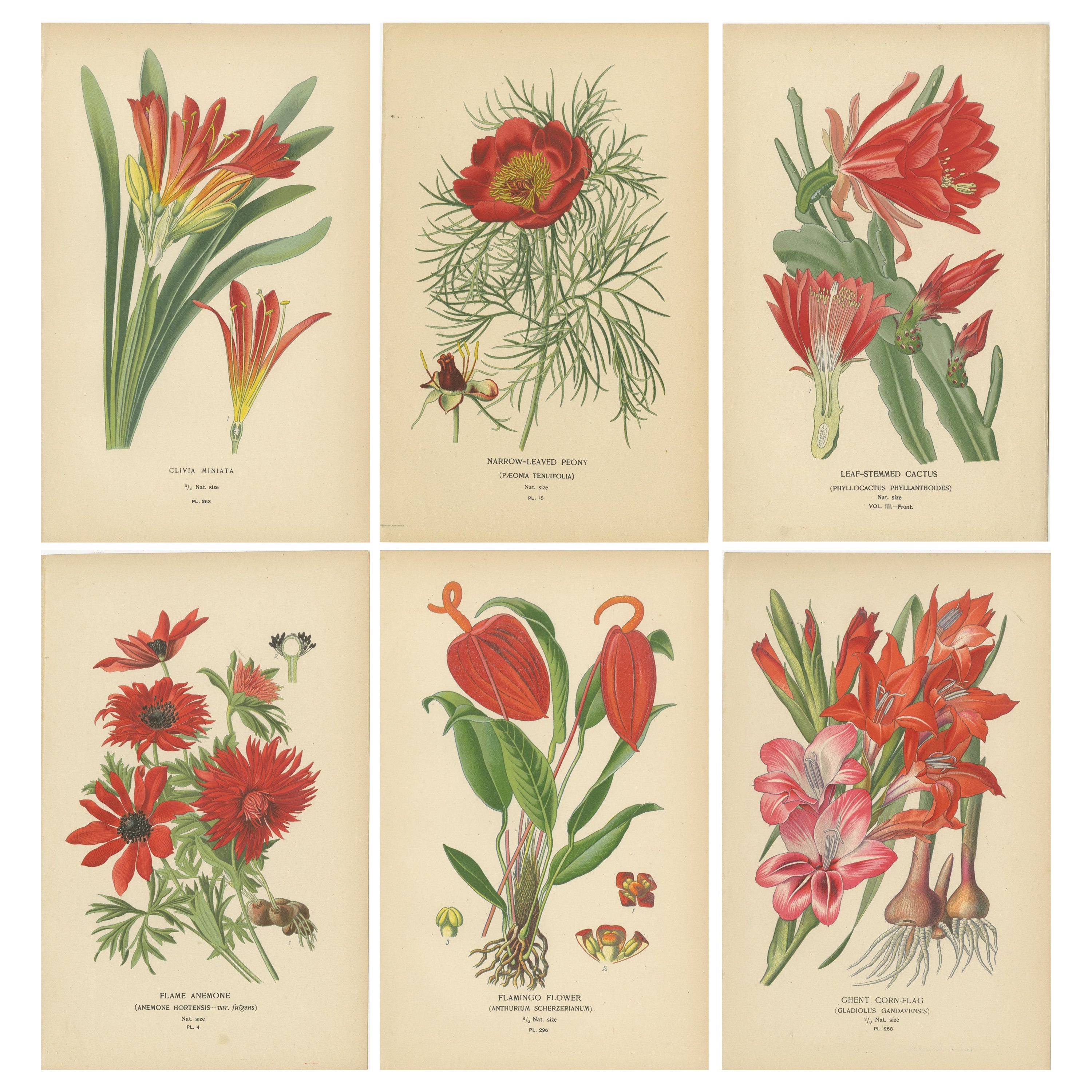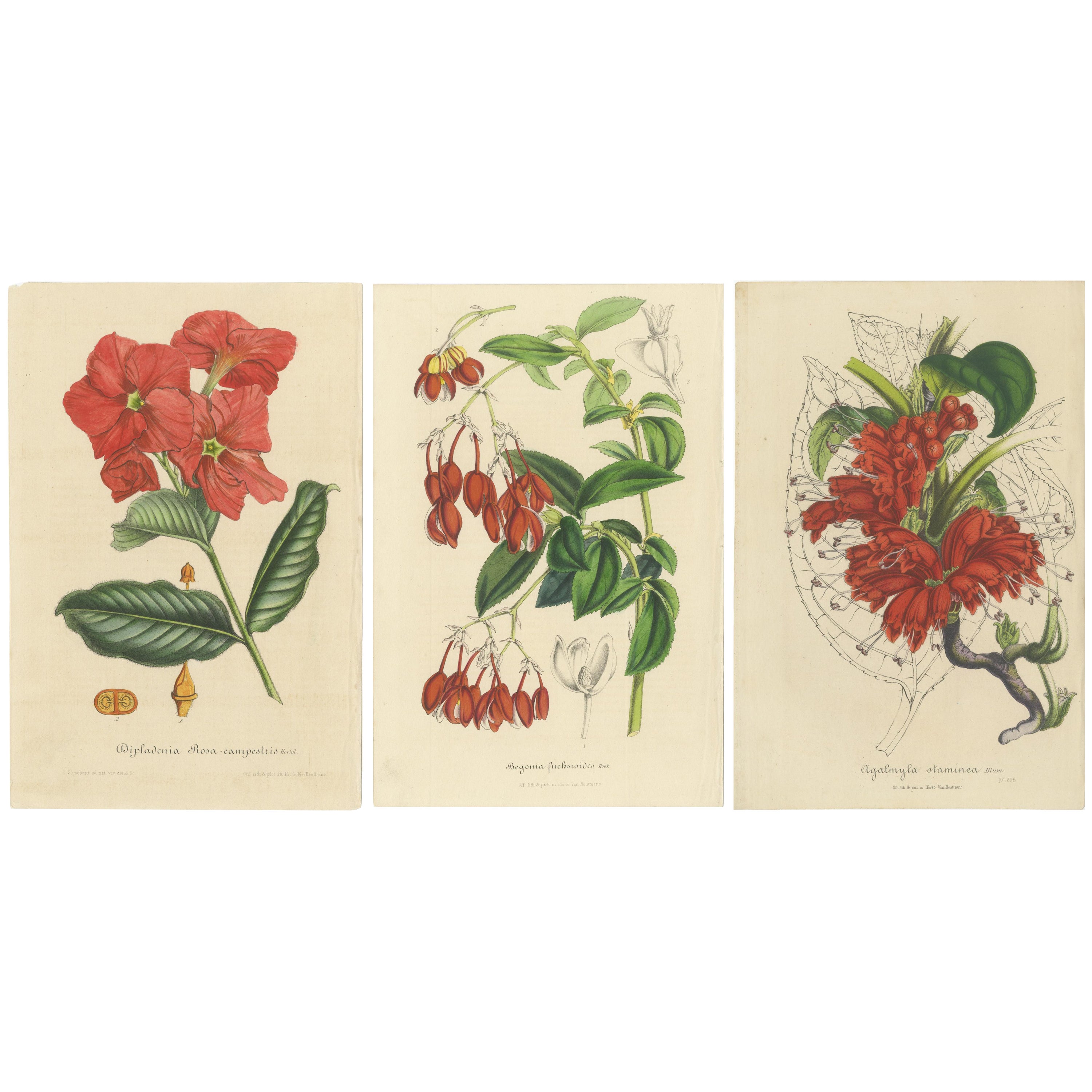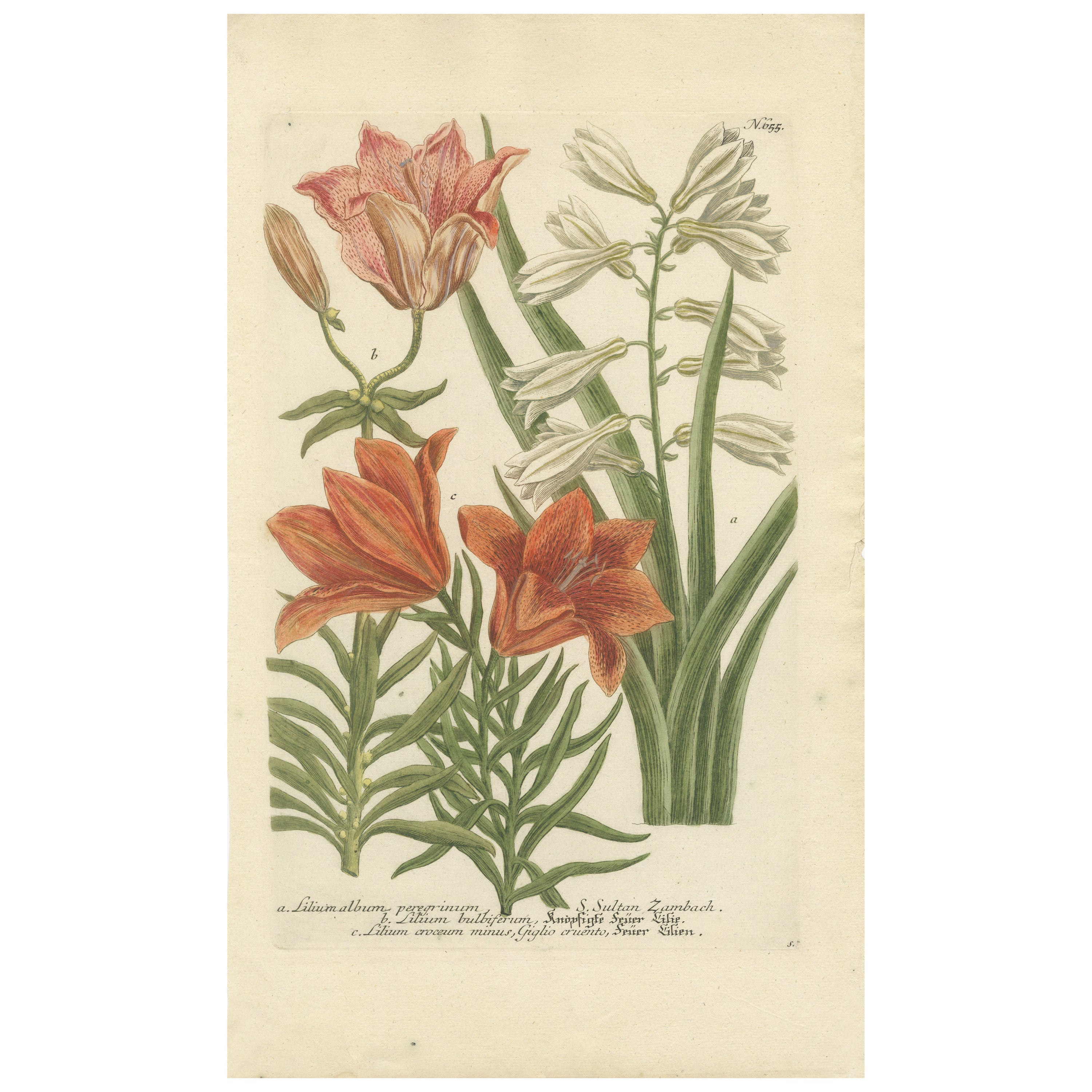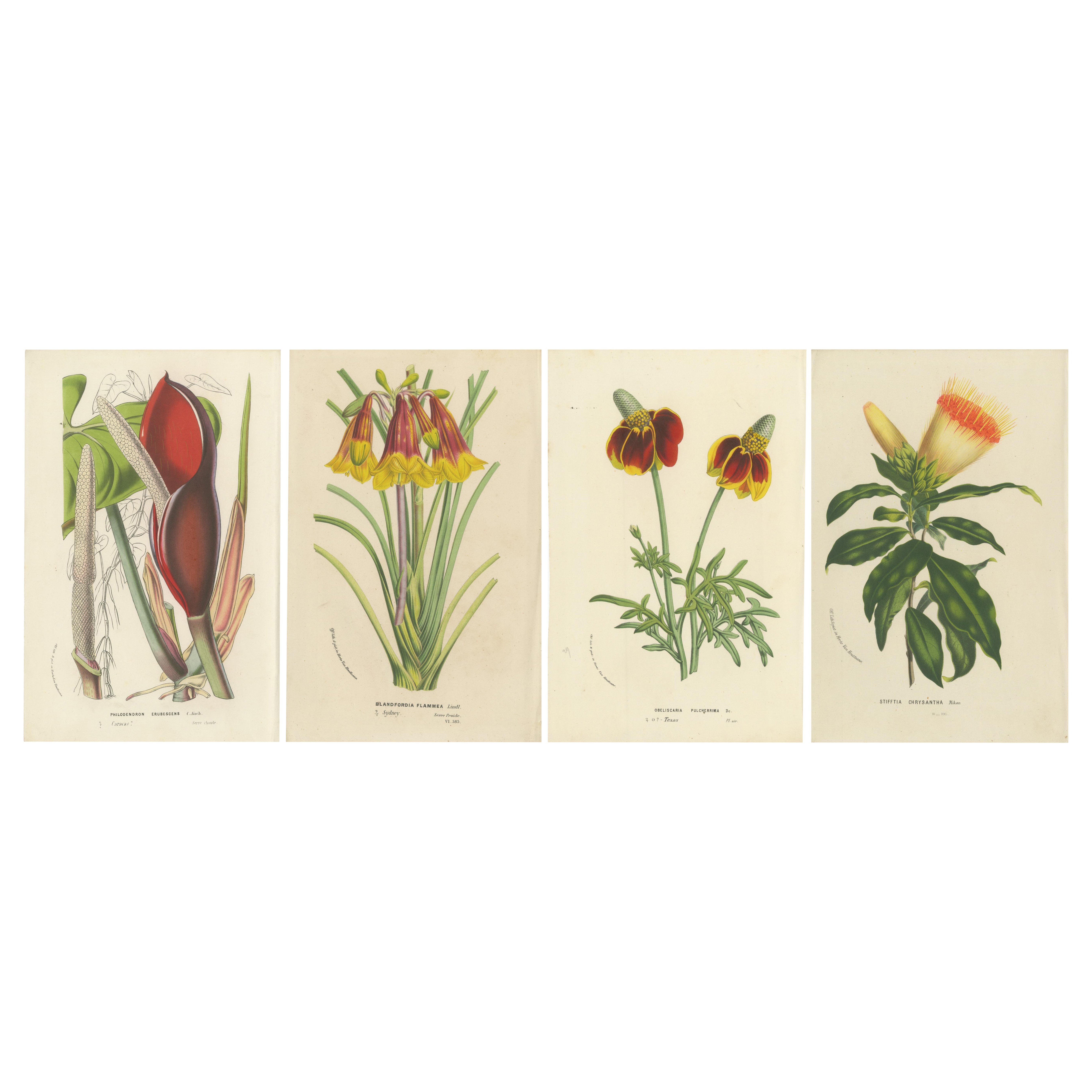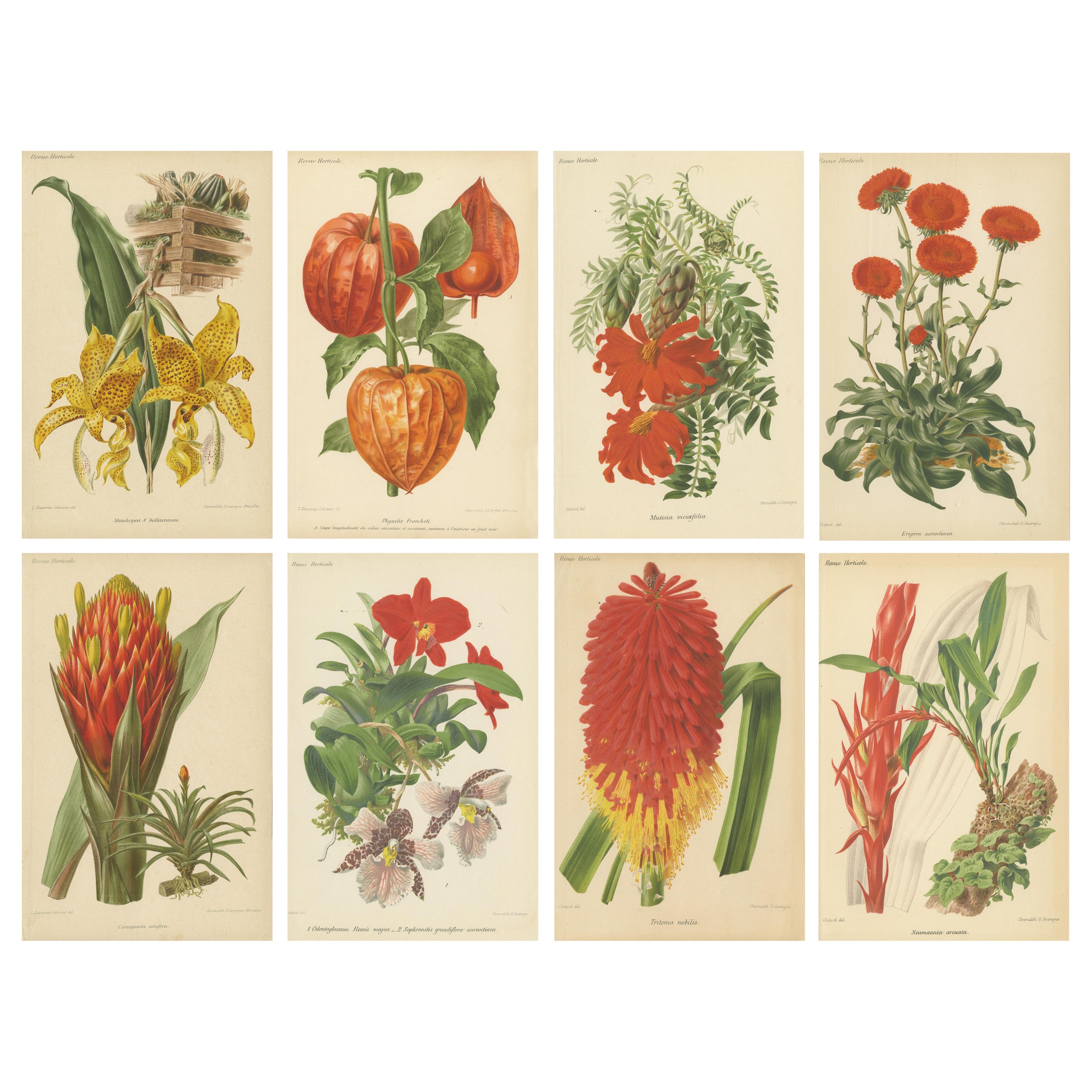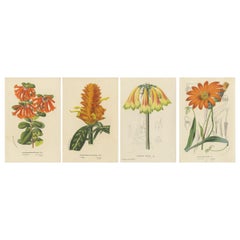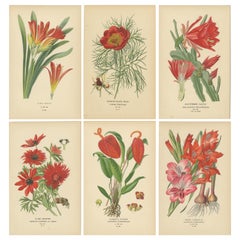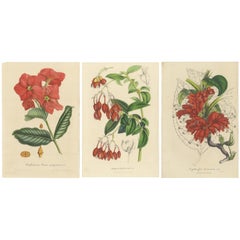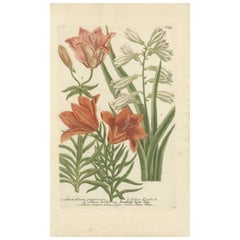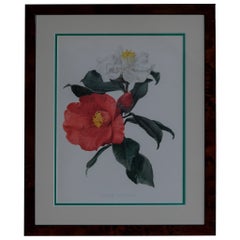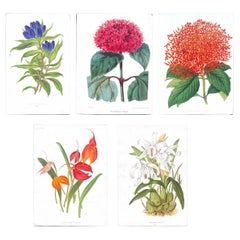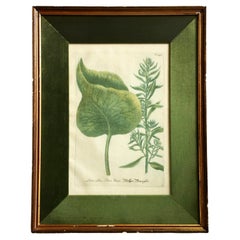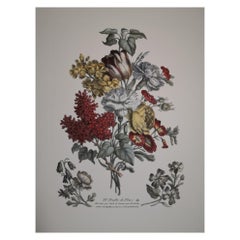Items Similar to Enchanted Blossoms: Masterpieces of Botanical Art from Van Houtte's Florilegium
Want more images or videos?
Request additional images or videos from the seller
1 of 7
Enchanted Blossoms: Masterpieces of Botanical Art from Van Houtte's Florilegium
$133.61
$167.0120% Off
£98.78
£123.4720% Off
€112
€14020% Off
CA$183.77
CA$229.7220% Off
A$204.28
A$255.3420% Off
CHF 107.08
CHF 133.8520% Off
MX$2,494.70
MX$3,118.3720% Off
NOK 1,336.79
NOK 1,670.9920% Off
SEK 1,257.67
SEK 1,572.0920% Off
DKK 852.65
DKK 1,065.8220% Off
About the Item
The plant depicted in the print on offer is Azalea mollis 'Glabrior', a variety of the Rhododendron species. Its common English name is the Smooth Azalea. This particular variety is noted for its lush, vivid orange flowers that can sometimes sport a reddish tint, making it a striking addition to any garden.
Description and Special Characteristics:
- Botanical Name: Azalea mollis 'Glabrior' Regel var.
- Origin: Native to Japan, this azalea is renowned for its robust growth and the spectacular display of large, trumpet-shaped flowers that bloom in magnificent clusters. The leaves are deciduous, dropping in the winter but providing a lush green backdrop during the flowering season.
- Flower Description: The flowers are particularly noteworthy for their size, vivid color, and the delicate patterning of freckles on the petals, which draw pollinators and admirers alike.
The Smooth Azalea is celebrated not only for its aesthetic appeal but also for its adaptability in temperate climates, making it a favorite among gardeners for both private gardens and public displays. The plant's ability to produce an abundance of flowers each spring, coupled with its relatively easy care, ensures its popularity in horticultural circles. Its vibrant color and full blossoms are often associated with the spring renewal, symbolizing peace and rejuvenation, which makes it a popular choice for many cultural and celebratory landscapes.
Context of the Botanical Print:
This beautiful botanical illustration comes from Louis Van Houtte's *Flore des Serres et des Jardins de l'Europe*, a work published between 1845 and 1883. Van Houtte, a premier horticulturist and nursery owner, featured plants like this Azalea in his catalog, which also functioned as an elaborate display of the most desirable plant species of the time. Orchids, roses, camellias, and other exotic plants were also highlighted, reflecting the Victorian era's fascination with botanical collections and the lush, vivid portrayal that chromolithography enabled.
This print not only serves as a historical document of horticultural interests and trends of the 19th century but also as a piece of art that captures the beauty and diversity of garden plants cultivated during Van Houtte's time. The condition of the print, as described, with minor marks typical for its age, suggests that it has been well-preserved, making it a valuable piece for collectors and enthusiasts of botanical art.
The botanical print of Azalea mollis 'Glabrior' comes from Louis Van Houtte's work, Flore des Serres et des Jardins de l'Europe, which was published over a span from 1845 to 1883. Given the style and the advanced chromolithography used in the print, it is likely from the latter part of this period. Therefore, a rough estimate would place the publication of this specific print towards the late 1870s or early 1880s. This timeframe would be consistent with the technological advancements and aesthetic styles represented in the print.
The technique used for the botanical print of Azalea mollis 'Glabrior' is chromolithography. This method was a revolutionary form of color printing from the 19th century that allowed for vibrant, multi-color illustrations. Chromolithography involves using multiple lithographic stones, each inked with a different color, to produce the final print. Each color requires a separate stone, and the meticulous alignment of these stones was crucial for achieving the detailed and vivid results characteristic of Louis Van Houtte's botanical illustrations. This technique allowed for high-quality, artistically appealing reproductions of original botanical artwork, making it highly popular for the illustration of prestigious works like *Flore des Serres et des Jardins de l'Europe*.
- Dimensions:Height: 6.42 in (16.3 cm)Width: 9.85 in (25 cm)Depth: 0 in (0.02 mm)
- Materials and Techniques:
- Period:
- Date of Manufacture:Circa 1875
- Condition:Condition: Good, given age. General age-related toning and/or occasional minor defects from handling. Colors are vivid, brownish around the edge, lower border cut short. Please study scan carefully.
- Seller Location:Langweer, NL
- Reference Number:Seller: BG-13761-121stDibs: LU3054341423772
About the Seller
5.0
Recognized Seller
These prestigious sellers are industry leaders and represent the highest echelon for item quality and design.
Platinum Seller
Premium sellers with a 4.7+ rating and 24-hour response times
Established in 2009
1stDibs seller since 2017
2,607 sales on 1stDibs
Typical response time: <1 hour
- ShippingRetrieving quote...Shipping from: Langweer, Netherlands
- Return Policy
Authenticity Guarantee
In the unlikely event there’s an issue with an item’s authenticity, contact us within 1 year for a full refund. DetailsMoney-Back Guarantee
If your item is not as described, is damaged in transit, or does not arrive, contact us within 7 days for a full refund. Details24-Hour Cancellation
You have a 24-hour grace period in which to reconsider your purchase, with no questions asked.Vetted Professional Sellers
Our world-class sellers must adhere to strict standards for service and quality, maintaining the integrity of our listings.Price-Match Guarantee
If you find that a seller listed the same item for a lower price elsewhere, we’ll match it.Trusted Global Delivery
Our best-in-class carrier network provides specialized shipping options worldwide, including custom delivery.More From This Seller
View AllVibrant Botanical Portraits: Exquisite Plant Illustrations from the 19th Century
Located in Langweer, NL
These illustrations, executed with precision and rich coloration, are fine examples of chromolithography, a technique popular in the 19th century for its ability to produce vivid, mu...
Category
Antique 1870s Prints
Materials
Paper
$362 Sale Price / set
20% Off
Botanical Illustrations from the Victorian Era: A Visual Celebration of Flora
Located in Langweer, NL
These are vibrant chromolithographs from "Favourite Flowers of Garden and Greenhouse" by Edward Step, illustrated by Désiré Bois and published in 1896 by Frederick Warne & Co., Londo...
Category
Antique 1870s Prints
Materials
Paper
$467 Sale Price / set
20% Off
Exquisite Botanical Illustrations from Curtis’s Botanical Magazine (1847)
Located in Langweer, NL
These beautiful hand-colored botanical illustrations, drawn and lithographed by the renowned artist Walter Hood Fitch, were featured in Sir William Jackson Hooker's *"Curtis's Botanical Magazine,"* published in London in 1847. Fitch was one of the most prolific and skilled botanical illustrators of the 19th century, known for his ability to capture the intricate details and vibrant hues of the plants he depicted.
Sir William Jackson Hooker, a famous British botanist and the director of the Royal Botanic Gardens, Kew, commissioned these illustrations as part of his work to document newly discovered plants from around the world. The *Curtis’s Botanical Magazine* has been published since 1787 and remains one of the longest-running botanical periodicals.
Detailed Descriptions of Each Plant
#### 1. **Dipladenia Rosa-campestris** (*Hortul. ex Veitch*)
- **English Name**: Rose Dipladenia
- **Description**: This illustration showcases *Dipladenia rosa-campestris*, a striking flowering plant known for its showy pink to deep red trumpet-shaped flowers. Native to tropical regions of South America, particularly Brazil, *Dipladenia* belongs to the family Apocynaceae and is prized in horticulture for its vibrant blooms and ability to climb. Fitch's illustration emphasizes the waxy leaves and the vivid color of the petals, bringing the plant to life on the page.
#### 2. **Begonia fuchsioides** (*Hook.*)
- **English Name**: Fuchsia-flowered Begonia
- **Description**: The *Begonia fuchsioides* is depicted with its characteristic red, pendulous flowers, which closely resemble the blooms of fuchsia plants. This species of Begonia is native to tropical regions and is popular for its delicate, bell-shaped flowers and glossy leaves. Fitch’s attention to the arrangement of the leaves and the contrast between the flowers' vibrant red and the soft green leaves provides a lifelike representation of this exotic plant.
#### 3. **Agalmyla staminea** (*Blume*)
- **English Name**: Staminate Agalmyla
- **Description**: This illustration captures the unique red tubular flowers of *Agalmyla staminea*, a plant native to Southeast Asia. The species is part of the Gesneriaceae family and is known for its bright, showy flowers that grow in dense clusters. Fitch’s careful rendering of the plant’s leaves and the intricate veining, along with the vibrant red flowers, highlights his talent for bringing the botanical subject to life with both scientific accuracy and artistic flair.
### About the Makers
#### **Walter Hood Fitch** (Artist and Lithographer)
Walter Hood Fitch (1817–1892) was one of the most influential botanical artists of the 19th century, working primarily with Sir William Hooker and later his son, Joseph Dalton Hooker, at Kew Gardens. He produced thousands of illustrations for various botanical publications, including *Curtis’s Botanical Magazine*, where he was responsible for the majority of its plates from 1834 to 1877. Fitch’s mastery of lithography allowed him to create richly detailed and accurate depictions of plants, with a particular talent for illustrating both the botanical structure and the vibrant colors of flowers.
#### **Sir William Jackson Hooker** (Director and Editor)
Sir William Jackson Hooker (1785–1865) was a prominent British botanist and the director of the Royal Botanic Gardens, Kew. Under his leadership, Kew Gardens expanded its collection of plants from around the world, and Hooker was instrumental in promoting the scientific study and illustration of these species. As the editor of *Curtis’s Botanical Magazine*, Hooker collaborated with Fitch to document and share the beauty and diversity of plants with the scientific community and the public.
### The Lithographic Technique
Lithography, particularly chromolithography, was a crucial innovation in botanical illustration. Fitch was skilled in the traditional method of lithography, where an image was drawn onto a stone plate with a greasy substance and then inked for printing. Hand-coloring was often applied afterward to bring the prints to life, as seen in these illustrations. This method allowed for highly detailed, accurate representations of plants and their botanical features, making it invaluable for both scientific study and aesthetic appreciation.
### Conclusion
These prints from *Curtis’s Botanical Magazine* reflect the height of botanical art in the mid-19th century. The combination of Walter Fitch...
Category
Antique 1840s Prints
Materials
Paper
$410 Sale Price / set
20% Off
Botanical Elegance: Antique Engravings from Johann Weinmann's Masterpiece, 1748
Located in Langweer, NL
Artist or Maker: Johann Wilhelm Weinmann
Title: "Lilium album peregrinum. Lilium buliferum, Knöpfigte Feuer Lilien. Lilium croceum minus, Feuer Lilien."
Medium: Colored etching
Catal...
Category
Antique 1740s German Prints
Materials
Paper
$753 Sale Price
20% Off
Free Shipping
Flora Illustrated: A Collection of 19th Century Botanical Art, Published c.1875
Located in Langweer, NL
The prints depict various botanical species, each illustrated with detailed attention to the morphology of the plants, including leaves, flowers, and sometimes fruits or seeds. These...
Category
Antique 1870s Prints
Materials
Paper
$324 Sale Price / set
20% Off
Original Vintage Botanical Illustrations from Revue Horticole, circa 1855
Located in Langweer, NL
Here are descriptions of the eight botanical illustrations, including the Latin and English names of the plants, why they are significant, and details about the creators and the tech...
Category
Antique 1850s Prints
Materials
Paper
$639 Sale Price / set
20% Off
You May Also Like
Botanical Chromolithographs from: William Robinson's Flora & Sylva
Located in Kettering, GB
A collection of 16 original botanical chromolithograph print in colours from William Robinson’s 1903-1905 Flora & Sylva – A Monthly Review....
Category
Early 20th Century British Decorative Art
Materials
Paper
Bignonia venusta – Antique Botanical Chromolithograph, 1880s
Located in Fukuoka, JP
A striking original botanical print from the 1880s, featuring Bignonia venusta, also known as flame vine or orange trumpet vine. This brilliantly colored illustration captures the dr...
Category
Antique 19th Century French Prints
Materials
Paper
1736-45 Framed Botanical Engraving, Johann Wilhelm Weinmann
By Johann Wilhelm Weinmann
Located in Louisville, KY
Framed Botanical Engraving, Johann Wilhelm Weinmann. Johann Wilhelm Weinmann (German 1683-1741) Published in Amsterdam & Ratisbon, 1736-45....
Category
Antique Mid-18th Century German Other Prints
Materials
Velvet, Giltwood, Paper
Italian Contemporary Hand Painted Botanical Print "VI° Feuilles de Fleurs"
Located in Scandicci, Florence
Elegant hand-watercoloured print representing "VI° Feuilles de Fleurs" a collection "Dessines par Carl et Gre es par Roubillac".
This botanical style print is available in 2 differe...
Category
21st Century and Contemporary Italian Wallpaper
Materials
Paper
Set of Two Rare Botanical Engravings by D’Orbigny — 1849
Located in Fukuoka, JP
Set of Two Rare Botanical Engravings by D’Orbigny — Dictionnaire Universel d’Histoire Naturelle, Paris, 1849
An exquisite pair of original hand-colored botanical engravings from the...
Category
Antique 19th Century French Prints
Materials
Paper
Original 1880s Botanical Print of Hæmanthus Kalbreyeri — Vibrant Antique Chromol
Located in Fukuoka, JP
A striking original chromolithograph from the 1880s, this botanical print features the dramatic Hæmanthus kalbreyeri, also known as the blood lily. Characterized by its intense red s...
Category
Antique 19th Century French Prints
Materials
Paper
More Ways To Browse
Antique Azaleas
Chinese Enamel Ginger Jars
Chinese Hardstone Carving
Chinese Jewelry Cabinet
Chinese Jewelry Cabinets
Chinese Wood Guanyin
Chinoiserie Teapot
Clothes Horse Antique
Coach Leather Furniture
Cobalt Blue Porcelain And Bronze Urn
Crab Claw
Crockery Cabinet
Crystal Cat Vintage
Danish 3 Chest Of Drawers
Danish Desk Organizer
Decorative Crafts Inc Brass
Delft Large Jars
Discus Thrower
